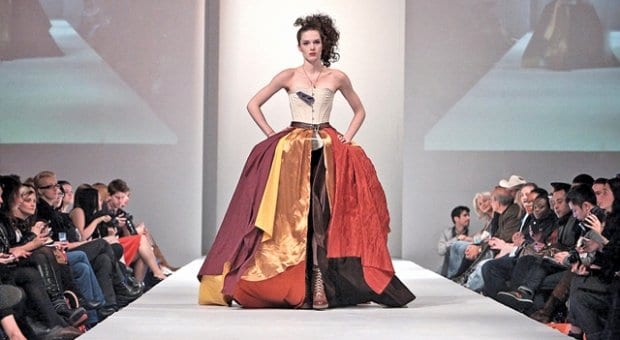Fashion Art Toronto is the best damn fashion event in this city.
The eighth annual amalgamation of fashion, art, music and more fashion features designers who span any look you could want, from dark and edgy, to romantic and dreamy, to experimental and wild. Joe Fresh, this ain’t! This year I skipped World MasterCard Fashion Week altogether, and when people asked me why, I simply said, “Because FAT is better.” It has the vision, the creativity and the ethic that the industry as a whole should have, and it all comes from the brain of Vanja Vasic, FAT’s founder and director. If you think fashion is all vacuous superficiality, she’s out to prove you wrong.
“We see art as conceptual, something to make a social impact or engage the community, and I think fashion must be looked at in this way as well,” says Vasic, who has built FAT from a personal project into an international event that sits at the vanguard of art, glamour and fashion.
Her excitement is palpable when she talks about one of this year’s featured designers, Henry Navarro. He’s a Ryerson professor who hails from Cuba who drew his fashion inspiration from modern-day racial segregation in (of all places) Cincinnati, Ohio. Have the words “fashion” and “Cincinnati” ever appeared together in print before? It’s not the first place one thinks of when looking for inspiration. Even in 2013 in that city, there’s not a whole lot of social mixing going on. “His collection was made by people there through workshops and groups involving black and white people. For many of the participants, it was the first time they’d talked to or even communicated in any way, shape or form with someone of a different race. His collection reflects the merging of different races. It’s unifying and features deconstructed elements and layering.” It’s also one of the bigger shows of the week; Navarro will be presenting 20 looks.
Those looking for a menswear show should keep their eyes peeled for Kollar Clothing. David Kollar is something of a wunderkind: a 23-year-old menswear designer who is celebrating his first FAT show, yet he didn’t go to school for design. Even so, he has an eagle eye — Vasic notes that “little details define his collection.” Small but deliberate choices of colour, pockets and fasteners all jump out at me; it’s vintage in feel. Kollar Clothing’s clean-cut style has some bad-boy edges, and the overall effect is casually masculine and sexy. I’d be happy to date a man whose closet was full of Kollar.
Designers aside, I have always admired FAT’s foundation of diversity and inclusion. The fashion industry isn’t necessarily known for those things — Vasic pulls no punches in saying flatly that it’s “mostly white.” When asked how much the idea of diversity informs FAT’s selection of models, Vasic makes it clear this is a topic she’s passionate about. “It’s not about filling a gap and saying, ‘Let’s put in 10 black models and 10 white models and we’re done.’ People love to see diversity on the runway; they crave it. We have to incorporate different types of people into collections, because those are the people who will be making the clothes come alive. Seeing the same models in a lineup is boring, and I just can’t relate to it. How can any of us relate to ‘that girl?’ For us, it’s a priority to select people that are transgender or have tattoos and the full range of body types out there. It’s important to give men and women a positive message of acceptance.”
I was reminded of my recent participation in a fashion show for Ryerson student Daniel Drak. For the first time in a non-FAT setting, I was looking at a truly diverse group of male models: black, Asian, built, trans, chubby, skinny, tall, short and a sexy quadruple amputee who did the runway in his motorized wheelchair, lifting up his shirt so we could all salivate over his washboard abs. Vasic’s efforts are making a difference with the new generation of fashion industry aspirants, but within the broader industry, she says, “people aren’t always accepting, but we will keep pushing in this direction. We had our casting this week, and a black model came out to be seen; she has vitiligo on her face, but it’s totally symmetrical and beautiful. She was one of the most exciting people we saw that day because she was so different and not someone that you typically see on a catwalk… something that we think is an imperfection is actually perfect and fascinating and attractive.”
Toronto at Night appears in every second issue of Xtra.

 Why you can trust Xtra
Why you can trust Xtra


